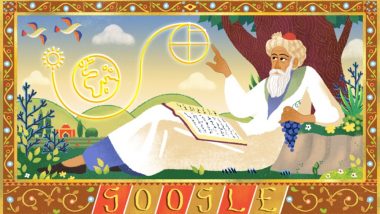Google today marked the 971st birth anniversary of popular Persian mathematician, astronomer and poet Omar Khayyam with a doodle. Born on May 18, 1048, in north-east Iran's Nishapur, Khayyam is known for his mathematical and scientific discoveries. He was born into a family of tent-makers (Khayyam) and his full name as it appears in the Arabic sources, was Abu’l Fath Omar ibn Ibrāhīm al-Khayyām. He was the first to come up with a solution for cubic equations. He also provided geometric solutions by the intersection of conics. Ruth Asawa, Japanese Artist Honoured by Google With a Doodle to Mark Beginning of Asian/Pacific American Heritage Month.
Khayyam became well known by the age of 22 following the publication of Treatise on Demonstration of Problems of Algebra and Balancing. He has also contributed to the understanding of the parallel axiom. In 2012 also, Omar Khayyam was honoured with a Google Doodle on his birth anniversary. Khayyam spent most of his life near the court of the Karakhanid and Seljuq rulers in the period which witnessed the First Crusade. He worked as an advisor and court astrologer to Malik Shah I in Khorasan province. Guided by scholars like Sheik Muhammad Mansuri and imam Mowaffaq Nishapuri, Khayyam increased in knowledge in both mathematics and astronomy. Olga Ladyzhenskaya: Google Celebrates Russian Mathematician's 97th Birthday by Dedicating Doodle.
His astronomical expertise led to the invention of the Jalali calendar which became the base of several other calendars and is said to be more accurate than the Gregorian calendar. He was also known for his writings, especially poems. Khayyam has written more than a thousand 'Rubaiyat' or verses. In 1859 English poet Edward Fitzgerald translated his poems and named it 'Rubáiyát of Omar Khayyám' which became popular in the West after Khayyam death. Molière Remembered as 'Greatest Artist in History of French Theater', Google Doodle Pays Tribute to French Actor and Playwright.
One of his discoveries in maths is said to have been lost. It was on the triangular array of binomial theorem the nth root of natural numbers. He also wrote 'Problems of Arithmetic', a book on music and algebra. He died on December 4, 1131, and was buried in the Khayyam Garden.
(The above story first appeared on LatestLY on May 18, 2019 09:02 AM IST. For more news and updates on politics, world, sports, entertainment and lifestyle, log on to our website latestly.com).













 Quickly
Quickly











